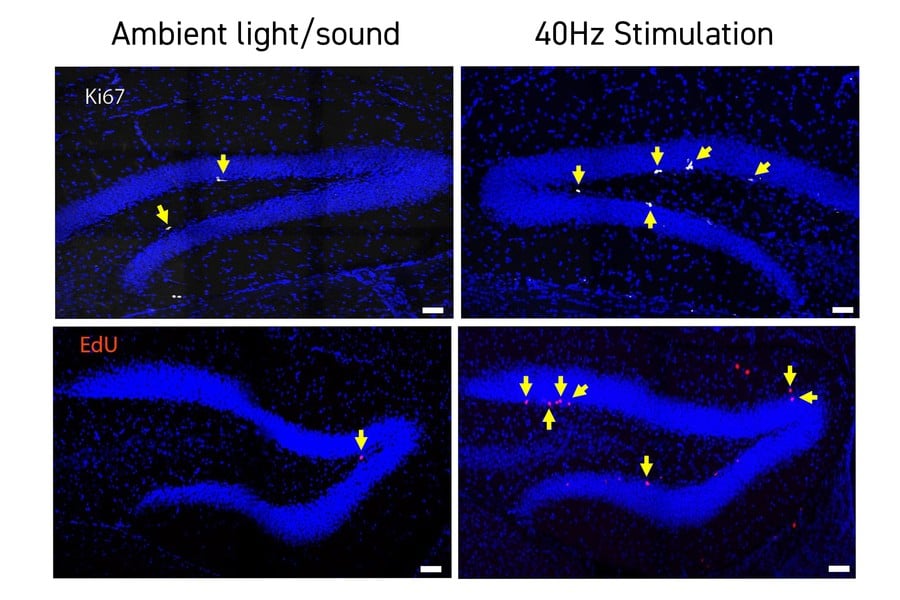MIT researchers have discovered that exposing mice with Down syndrome to specific light and sound patterns can significantly improve memory, enhance brain connectivity, and boost the formation of new neurons. This promising approach, which uses 40Hz sensory stimulation known as GENUS (gamma entrainment using sensory stimulation), could potentially open new avenues for treating cognitive challenges associated with Down syndrome.
How Multisensory Stimulation Transforms Neural Function
The study, published in PLOS ONE on April 24, 2025, revealed that Down syndrome model mice receiving just one hour of daily 40Hz light and sound stimulation for three weeks demonstrated remarkable improvements in memory and cognitive function.
“While this work, for the first time, shows beneficial effects of GENUS on Down syndrome using an imperfect mouse model, we need to be cautious, as there is not yet data showing whether this also works in humans,” said Li-Huei Tsai, Picower Professor at MIT and senior author of the study.
Nevertheless, the findings represent a significant step forward in understanding how sensory stimulation might help address neurological challenges associated with Down syndrome, which currently has limited therapeutic options.
Measurable Cognitive Improvements After Treatment
The research team, led by postdoc Md Rezaul Islam and Brennan Jackson, conducted several memory tests that revealed substantive cognitive benefits from the treatment. Mice receiving the gamma stimulation showed significantly better performance in object recognition and spatial memory tasks compared to untreated mice.
When tested on their ability to recognize novel objects, stimulated mice spent 64.1% of their time exploring new objects compared to just 48.6% for untreated mice. Similarly, in spatial memory tests, stimulated mice spent 73.4% of their time investigating objects in new locations versus only 46.6% for untreated mice.
Key Benefits Observed After 40Hz Stimulation
- Significant improvements in novel object recognition and spatial memory tasks
- Increased number of mature synapses (neural connections) in the dentate gyrus area of the hippocampus
- Enhanced adult neurogenesis – the formation of new neurons
- Increased expression of genes associated with synaptic organization
- Higher levels of Reelin-positive neurons, which are linked to cognitive resilience
These improvements did not relate to changes in general movement or anxiety levels, suggesting the cognitive benefits were directly related to the stimulation treatment rather than behavioral side effects.
Exploring the Cellular Mechanisms Behind Cognitive Improvement
To understand how the stimulation improved cognitive function, researchers examined gene expression in almost 16,000 individual brain cells. They discovered that 40Hz stimulation significantly altered gene expression patterns in excitatory neurons, with 108 genes showing increased activity and 104 genes showing decreased activity.
Many of these modified genes play crucial roles in forming and organizing synapses, the connections between neurons that enable communication within the brain.
“The increased putative functional synapses in the dentate gyrus is likely related to the increased adult neurogenesis observed in the Down syndrome mice following GENUS treatment,” explained Islam when discussing the relationship between new neurons and improved cognition.
Growth of New Neurons: A Notable Discovery
Perhaps the most striking finding was the evidence of increased neurogenesis – the birth of new neurons – in treated mice. The research revealed higher expression of TCF4, a key regulator for generating new neurons, in stimulated mice.
When researchers directly examined the brains, they found substantially more newly formed neurons in mice that received the gamma stimulation treatment. This represents the first documented evidence that GENUS stimulation increases neurogenesis, potentially explaining some of the cognitive improvements observed.
The stimulated mice showed nearly 50% more cell proliferation in the dentate gyrus region of the hippocampus, as measured by markers Ki67 and EdU, compared to untreated mice.
Broader Implications for Neurological Health
This study adds to a growing body of evidence suggesting that 40Hz sensory stimulation promotes broad neurological health benefits across various conditions. Previous research has demonstrated its effectiveness in Alzheimer’s disease models, “chemo brain,” and stroke recovery.
Of particular significance for Down syndrome patients is the finding that stimulation preserved cells expressing Reelin, a protein associated with resilience against Alzheimer’s disease. This is especially relevant since approximately 90% of people with Down syndrome develop Alzheimer’s disease after age 40.
While the current findings are promising, the researchers emphasize that more work is needed to determine whether these benefits would translate to humans. Tsai’s lab has already begun a small-scale study with human volunteers at MIT to explore this possibility.
As research continues, this non-invasive, drug-free approach could potentially offer a new therapeutic option for addressing cognitive challenges in Down syndrome and other neurological conditions—providing hope for those affected and their families.
Discover more from NeuroEdge
Subscribe to get the latest posts sent to your email.

